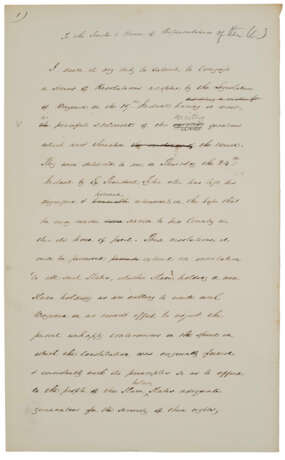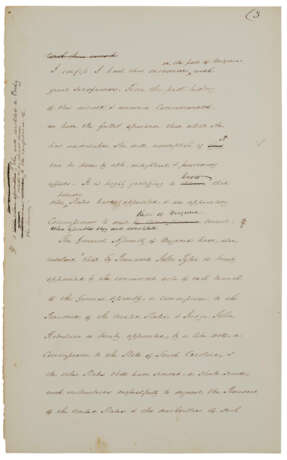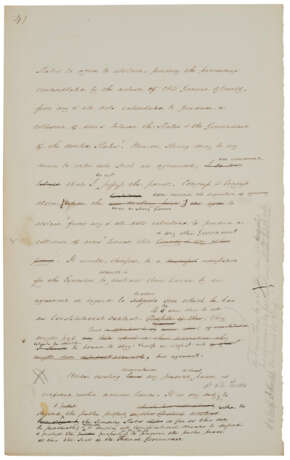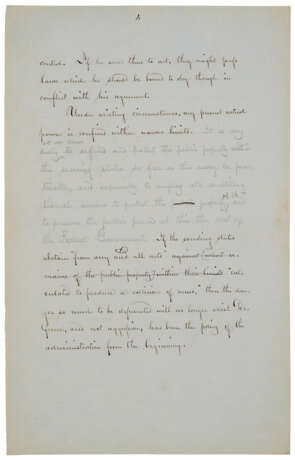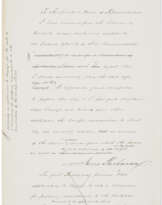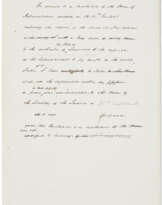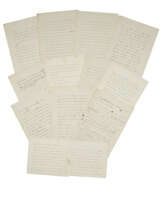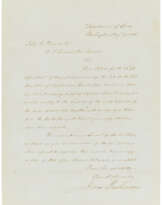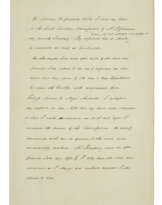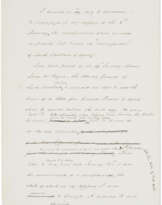ID 1119251
Lot 143 | On the Virginia Peace Resolutions
Valeur estimée
$ 80 000 – 120 000
James Buchanan, 28 January 1861
BUCHANAN, James. (1791-1868); GLOSSBRENNER, Adam John (1810-1889). Autograph manuscript, [Washington, 28 January 1861].
Eight pages, most 345 x 212mm, with a smaller leaf, 250 x 202mm & 120 x 210mm, in ink and some pencil (occasional toning and dustsoiling). Seven pages in the hand of Buchanan and one in the hand of Glossbrenner, his private secretary.
An optimistic Buchanan praises the Virginia Peace Resolutions calling for a peace conference in Washington. A hopeful message delivered in the wake of Virginia's proposal of staging a peace conference, while cautioning that the executive lacked the power to agree to any resolutions, noting that only Congress held such power: "I confess I hail this movement on the part of Virginia with great satisfaction. From the past history of this ancient and renowned Commonwealth, we have the fullest assurance that what she has undertaken she will accomplish, if it can be done by able, enlightened, and persevering efforts. It is highly gratifying to know that other patriotic States have appointed, and are appointing, commissioners to meet those of Virginia in council. When assembled, they will constitute a body entitled, in an eminent degree, to the confidence of the country . . . . However strong may be my desire to enter into such an agreement, I am convinced that I do not possess the power. Congress, and Congress alone, under the war-making power, can exercise the discretion of agreeing to abstain ‘from any and all acts calculated to produce a collision of arms’ between this and any other Government"
The Virginia resolutions came on the heels of three failed attempts at a compromise to prevent the breakup of the Union. The first, the Crittenden Plan, was presented in December and consisted of a series of conditional amendments including an extension of the Missouri Compromise line to run to the Pacific—a position that was rejected by a Congressional committee of 33 (representing each state)—in part because it violated the Republican position of not extending slavery further west. A modified version was proposed at the close of the year, but it was rejected by Congress on 4 January. Later the same month, the same committee drafted a constitutional amendment protecting slavery where it existed and allowing New Mexico to join the Union as a slave state. The fourth attempt at compromise came from Virginia, who had not yet seceded from the Union, and was presented by former President John Tyler to hold a peace conference in Washington that convened at the Willard Hotel on 4 February 1861. Unfortunately, none of the deep south states, most of whom had already seceded, attended the conference which met for three weeks. With only representatives from the upper South and many far western states absent, the conference proved a flawed effort at compromise, but it ended the resolution that proposed a connotational amendment that would protect slavery where it existed and allow the extension of slavery below the Missouri Compromise Line. The conferences resolution was rejected in the Senate by a large margin and never came to a vote in the House. Congress did approve the Corwin Amendment which protected slavery where it already existed—a position that even Lincoln believed was settled law under the Constitution—but embraced as a last-ditch effort at sectional compromise. Published in John Basset More, ed., The Works of James Buchanan. Philadelphia & London: J. B. Lippincott Company, 1910. Vol. 11, pp. 116-118.
| Artiste: | Adam John Glossbrenner (1810 - 1889) James Buchanan (1791 - 1868) |
|---|---|
| Catégorie maison de vente aux enchères: | Lettres, documents et manuscrits |
| Artiste: | Adam John Glossbrenner (1810 - 1889) James Buchanan (1791 - 1868) |
|---|---|
| Catégorie maison de vente aux enchères: | Lettres, documents et manuscrits |
| Adresse de l'enchère |
CHRISTIE'S 20 Rockefeller Plaza 10020 New York Etats-Unis | ||||||||||||||
|---|---|---|---|---|---|---|---|---|---|---|---|---|---|---|---|
| Aperçu |
| ||||||||||||||
| Téléphone | +1 212 636 2000 | ||||||||||||||
| Fax | +1 212 636 4930 | ||||||||||||||
| Conditions d'utilisation | Conditions d'utilisation | ||||||||||||||
| transport |
Service postal Service de messagerie ramassage par vous-même | ||||||||||||||
| Modes de paiement |
Virement bancaire | ||||||||||||||
| Heures d'ouverture | Heures d'ouverture
|
